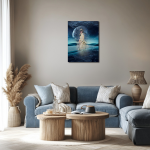Camille Among the Moons: Trouville Beyond the Veil
Camille Among the Moons: Trouville Beyond the Veil reimagines Monet’s 1870 portrait as a surreal celestial vision, where Camille stands beneath alien skies and moons that echo time. Suspended on a reflective sea of frozen memory, she drifts between presence and myth, her form held in soft gravity and dreamlight. This piece explores love, loss, and the transformation of memory into cosmic reverie.
Please see Below for Details…
Hotline Order:
Mon - Fri: 07AM - 06PM
404-872-4663
Claude Monet’s Camille on the Beach at Trouville , painted in 1870, is a gentle, sunlit impression of a woman in repose—Camille Monet, dressed in white, delicately set against the breeze and salt air of the Normandy coast. In its original form, the painting captures a fleeting moment of light, wind, and presence. Camille stands quietly, her parasol catching the light, her dress dancing slightly in the soft movement of sea and air. It is a study in serenity, elegance, and the intimate grace of observation. In this surreal reinterpretation, titled Camille Among the Moons: Trouville Beyond the Veil , that shoreline vanishes entirely. The beach becomes an interplanetary horizon. Camille remains—but she is no longer of Earth. She walks now between planets and frozen tides, her form held in the quiet gravity of memory and starlight.
At the center of the composition, Camille’s figure still echoes the fluid brushwork of Monet’s hand. Her dress is pale, textured, fraying gently into the atmosphere, as if her edges were becoming indistinct, lost in the dream around her. The expression of her face is soft, veiled, not fully formed—an intentional distortion that elevates her from portrait to presence. Her body floats slightly, unanchored by shadow or mass, as though the act of memory itself is struggling to hold her. She stands not on sand, but on a mirrored surface that reflects only light and absence, like a frozen ocean beneath a glass sky.
The background transforms the terrestrial into the mythic. Behind Camille, a colossal moon dominates the heavens. Its surface is rough, cratered, ancient—a world watching her from behind. Multiple smaller planets orbit in the distance, suspended in a night that holds neither threat nor warmth. These celestial bodies do not cast light. They observe. They echo. They exist as symbols of distance, of time stretched beyond comprehension. Their presence does not frame Camille—it expands her, situating her in a cosmos that is vast, cold, and infinitely still.
The clouds above swirl like oil on water, each fold of atmosphere rich with motion and yet utterly silent. This is not a sky painted with brushes, but a dream projected in feeling. There is no sun, only glow. No breeze, only stillness. Light moves slowly across the scene, grazing Camille’s form as though remembering her rather than illuminating her. She is not lost, but she is fading—held together by the very memory that cannot release her.
The sea, once a familiar backdrop to Monet’s coastal paintings, is here reimagined as a landscape of liquid dusk. It no longer ripples. It breathes. Its waves are frozen in mid-movement, like folds of silk caught in windless space. The reflection of Camille is faint—less a mirror, more a ghostly echo—emphasizing the tension between physical presence and emotional resonance. The horizon no longer divides sea from sky. It merges them, dissolving the notion of ground, of path, of direction. Camille is suspended in this quiet infinity, moving without motion, seen without being fully visible.
Color plays a critical role in guiding the emotional tone of this piece. The cool palette—icy blues, ghostly greys, soft lunar whites—creates a sense of quiet longing. There are no vibrant hues, no warm distractions. Every tone feels distant, as if filtered through water or sleep. Camille’s form, though painted in cream and pale gold, does not radiate warmth. She is the memory of light, not the source. Her presence is felt before it is fully seen, like the last moment before waking.
As the artist, I approached this reinterpretation not as a reinvention, but as a return—a journey back through layers of perception, to a place where Camille’s memory floats freely, untethered by time or location. Camille on the Beach at Trouville once captured a moment of ordinary beauty. This new vision seeks to reveal the extraordinary gravity behind that moment—the way presence becomes myth, how love transforms figure into star, how grief reshapes even the brightest day into a moonlit shore.
This Camille is not alone, nor is she watched. She is held—by light, by memory, by time. Her posture is still, yet filled with story. Each line of her dress, each soft blur of her outline, whispers of the hands that once painted her, the voice that once called her name, the wind that once touched her cheek. Here, she remains—not in time, but in resonance.
Add your review
Your email address will not be published. Required fields are marked *
Please login to write review!
Looks like there are no reviews yet.








